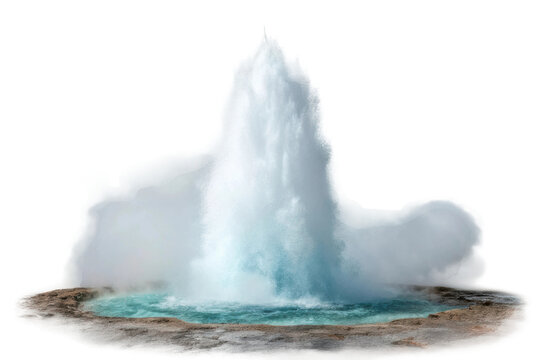A geyser is a hydrothermal spring that episodically discharges columns of hot water and steam from a surface vent. The term derives from the Icelandic “Geysir,” meaning “to gush,” and refers to the historically active Great Geysir in southwest Iceland. According to Encyclopaedia Britannica, geysers are rare because they require a combination of heat, water recharge, and a subsurface hydraulic system that traps and periodically releases pressurized fluids. Britannica. (
britannica.com)
Formation and mechanism
- –Heat is supplied by shallow magmatic systems that elevate groundwater temperatures well above surface boiling conditions; in areas like Yellowstone National Park, meteoric water circulates deep enough to be heated above 90–100°C at the surface due to pressure at depth. As pressure drops during an eruption, liquid flashes to steam, converting thermal energy to kinetic energy that drives the jet.
U.S. Geological Survey;
Annual Reviews. (
usgs.gov)
- –A defining feature is a constriction in the conduit that throttles flow and allows superheating; once steam bubbles force water past the constriction, pressure falls rapidly and vigorous boiling ensues. The National Park Service describes this process for both cone and fountain geysers in Yellowstone.
NPS. (
nps.gov)
Types and deposits
- –Cone geysers erupt as narrow jets from silica-built cones; fountain geysers erupt in bursts from pools with broad vents. These morphologies reflect plumbing geometry and silica deposition at the vent.
NPS. (
nps.gov)
- –Geyser waters circulating through rhyolitic rocks dissolve silica and precipitate siliceous sinter (geyserite) at the surface. Newly formed sinter comprises amorphous opal-A that progressively matures to quartz; microbial mats often catalyze and become incorporated into these deposits.
U.S. Geological Survey. (
usgs.gov)
Geographic distribution
- –Yellowstone hosts more than 500 active geysers—about half of the global total—concentrated in the Upper, Midway, and Lower Geyser basins near Old Faithful.
NPS;
Britannica. (
home.nps.gov)
- –Russia’s Kronotsky Reserve contains the Valley of Geysers, a UNESCO World Heritage area in Kamchatka with roughly ninety geysers in a 6‑km basin; a large landslide in June 2007 buried part of the valley but activity persists.
UNESCO;
NPS exhibit. (
whc.unesco.org)
- –El Tatio in northern Chile’s Andes (∼4,320 m elevation) is among the world’s largest geyser fields and contains on the order of 80 erupting geysers. Peer‑reviewed studies of its plumbing and activity confirm numerous geysers and strong morning steam plumes at local boiling temperatures.
Journal of Geophysical Research. (
agupubs.onlinelibrary.wiley.com)
- –New Zealand’s Taupō Volcanic Zone includes Whakarewarewa and Waimangu; the Pōhutu geyser at Rotorua is the largest regularly active geyser in the Southern Hemisphere, while the historic Waimangu Geyser near Rotorua (active 1900–1904) produced the greatest recorded eruption heights before becoming extinct.
Britannica;
Guinness World Records. (
britannica.com)
- –Iceland’s Haukadalur valley contains the Great Geysir and Strokkur; the Icelandic name of Geysir gave rise to the generic term “geyser.”
Britannica. (
britannica.com)
Notable geysers and eruption behavior
- –Old Faithful is a cone geyser whose eruptions typically last 1.5–5 minutes, reach roughly 30–55 m, and recur at average intervals near 90 minutes; Yellowstone rangers predict the next eruption using the duration of the previous one.
NPS;
Britannica. (
nps.gov)
- –Steamboat Geyser in Norris Geyser Basin is the world’s tallest active geyser; major eruptions exceed 90 m (300 ft) and are irregular, separated by days to years.
NPS;
USGS/YVO. (
nps.gov)
- –The tallest reliably documented geyser in history was New Zealand’s Waimangu Geyser, which reached heights up to about 460 m in 1903 before falling dormant in 1904.
Guinness World Records. (
guinnessworldrecords.com)
Hydrology, chemistry, and microbiology
- –Yellowstone’s hydrothermal fluids are meteoric waters that circulate to depth, are heated near magmatic bodies, and rise buoyantly; near-surface mixing and pressure changes govern whether features appear as hot springs, fumaroles, mud pots, or geysers.
U.S. Geological Survey. (
usgs.gov)
- –Sinter deposits around vents often entomb microbial mats; these mats can constitute a substantial fraction of sinter volume and influence silica precipitation textures.
U.S. Geological Survey. (
usgs.gov)
- –Fossil geyserite and hot-spring sinter in the 3.48‑billion‑year‑old Dresser Formation (Western Australia) preserve biosignatures interpreted as some of the earliest evidence of life on land.
Nature Communications. (
pmc.ncbi.nlm.nih.gov)
Human impacts, hazards, and conservation
- –Geysers are sensitive to changes in groundwater supply, earthquakes, and human activity. In Rotorua, New Zealand, widespread geothermal well drilling led to declines in geyser activity; a late‑1980s well‑closure program was followed by partial recovery. [Geothermics (journal)](journal://Geothermics|Changes in thermal activity in the Rotorua geothermal field|1992);
Whakarewarewa overview. (
en.wikipedia.org)
- –Hydrothermal areas can cause severe burns; park agencies mandate boardwalks and safety guidelines around geyser basins.
NPS. (
nps.gov)
Beyond Earth
- –Plume activity on Saturn’s moon Enceladus is often described as geyser‑like: fissures at the south pole vent water vapor, ice particles, and organics from a subsurface ocean, with jets mapped by Cassini and JWST. Such “cryogeysers” differ in composition and temperature from terrestrial geysers but illustrate pressure‑driven jets in cold environments.
NASA;
NASA/JPL;
ESA. (
nasa.gov)
